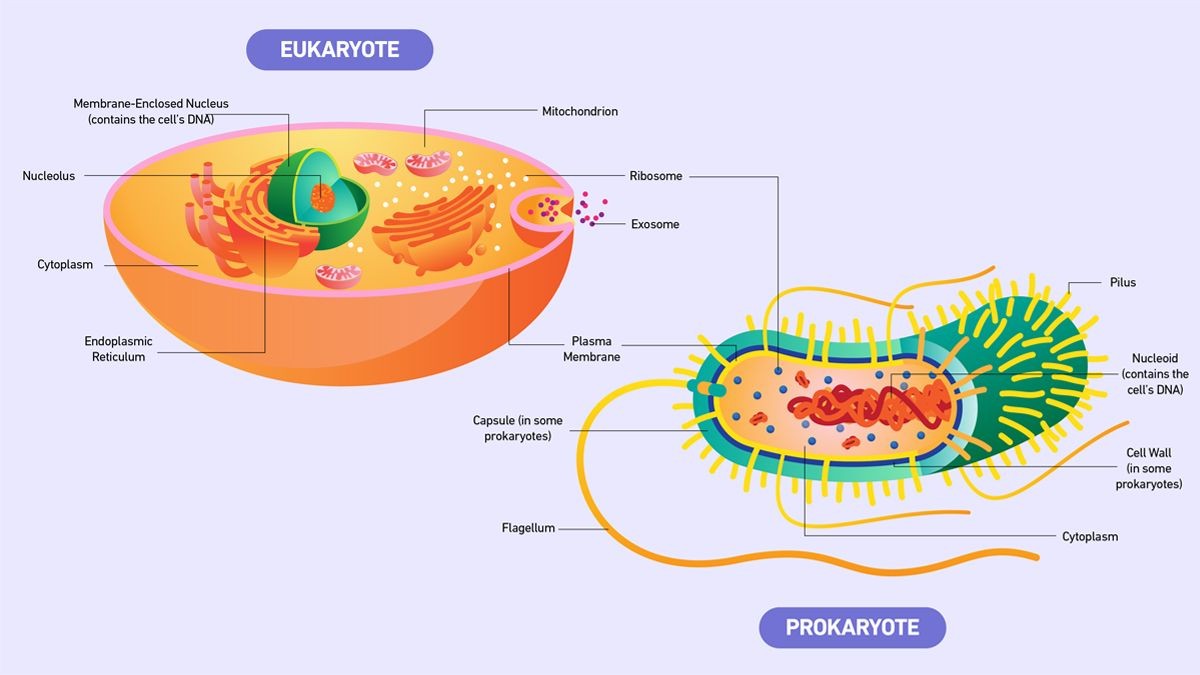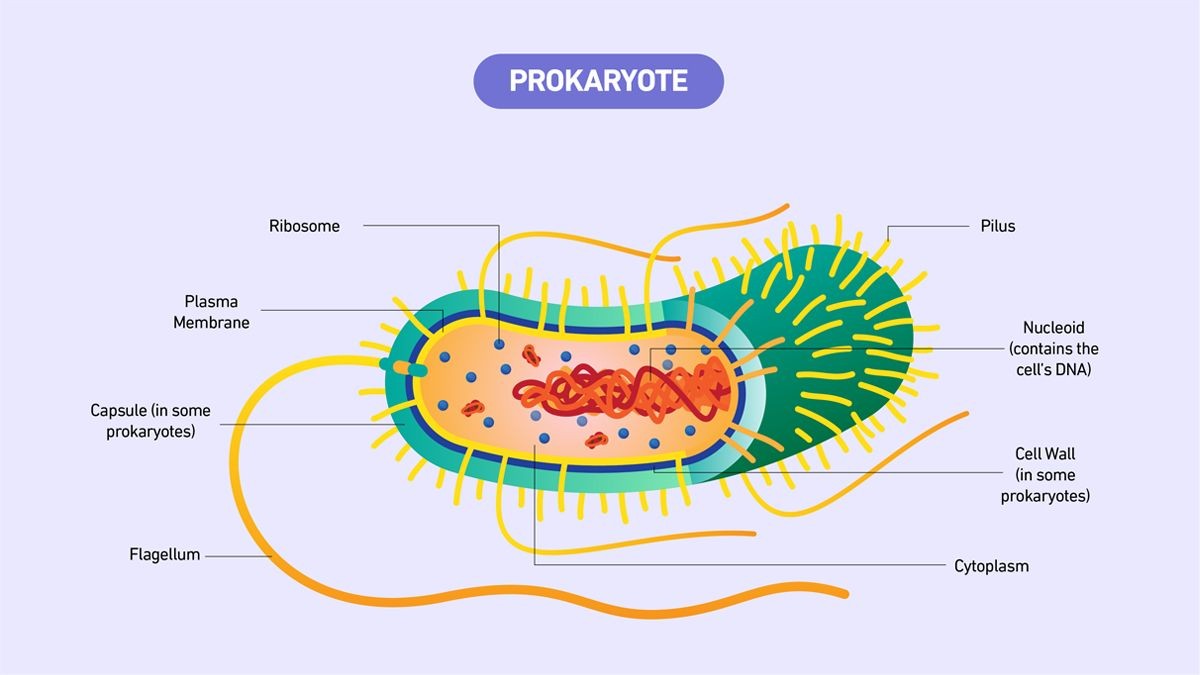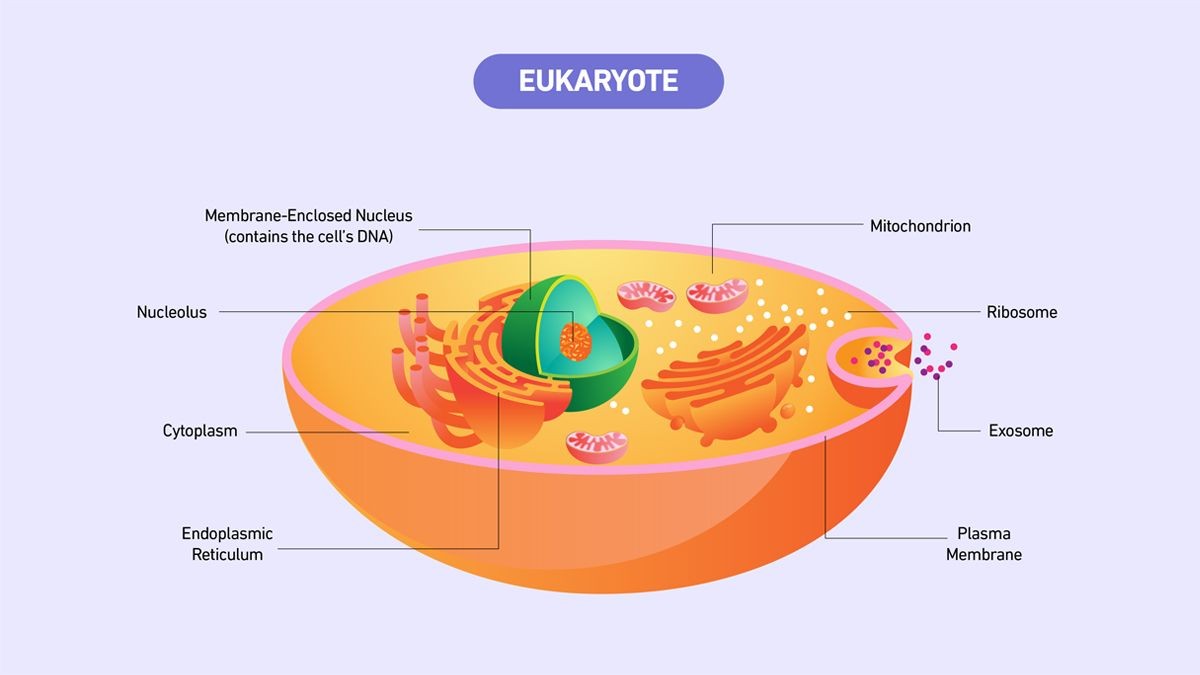How Do Prokaryotic Cells Compare To Eukaryotic Cells? Prokaryotic and eukaryotic cells represent the fundamental building blocks of life, each with unique structures and functions. At COMPARE.EDU.VN, we offer a detailed comparison to clarify these differences, helping you understand their distinct roles and evolutionary significance. Delve into cell biology, cell structure and molecular biology.
1. Comparing Prokaryotic and Eukaryotic Cells
Prokaryotic cells, the earliest form of life, predate eukaryotic cells by billions of years. Scientists propose that eukaryotic cells evolved from prokaryotic ancestors around 2.7 billion years ago.
The most accepted theory suggests that eukaryotes arose through a symbiotic relationship where two prokaryotic cells merged, a process known as endosymbiosis. This event led to the development of membrane-bound organelles like mitochondria, providing the energy necessary for eukaryotic cells to evolve into more complex forms.
Recent research from the University of Jena, published in mBio, challenges previous assumptions. It demonstrates that certain prokaryotic bacteria can engulf other cells, a process previously thought exclusive to eukaryotes. This challenges the traditional understanding of endocytosis and the origins of eukaryotic cells.
The primary distinction lies in the presence of a membrane-bound nucleus in eukaryotic cells, which houses their genetic information. In contrast, prokaryotic cells lack a nucleus; their DNA resides in the nucleoid region without a surrounding membrane.
In addition to the nucleus, eukaryotes feature numerous membrane-bound organelles that compartmentalize cellular functions. Prokaryotes lack these organelles. The structure and location of DNA also differ significantly. Eukaryotic DNA consists of multiple linear, double-stranded molecules within the nucleus, while prokaryotic DNA is typically circular, double-stranded, and located in the cytoplasm. However, linear plasmids and chromosomes have been observed in some prokaryotes.
2. Key Similarities Between Prokaryotes and Eukaryotes
Despite their differences, prokaryotic and eukaryotic cells share fundamental characteristics:
All cells, whether prokaryotic or eukaryotic, share these four features, as shown in Figure 1:
- DNA: Both cell types use DNA as their genetic material.
- Plasma membrane: A barrier separating the cell’s interior from the external environment.
- Cytoplasm: The gel-like substance filling the cell, containing various cellular components.
- Ribosomes: Structures responsible for protein synthesis.
These common features underscore the shared ancestry and basic life processes of all cells.
3. What Are the Key Differences Between Prokaryotes and Eukaryotes?
Prokaryotes and eukaryotes differ significantly in several aspects, including cell structure, the presence or absence of a nucleus, and the presence of membrane-bound organelles. The following table summarizes these key distinctions:
Table 1: Differences Between Prokaryotes and Eukaryotes
| Feature | Prokaryote | Eukaryote |
|---|---|---|
| Nucleus | Absent | Present |
| Membrane-bound organelles | Absent | Present |
| Cell Structure | Unicellular | Mostly multicellular; some unicellular |
| Cell Size | Typically smaller (0.1–5 μm), however, a much larger (centimeter-long) bacterium has recently been discovered in a mangrove swamp. | Larger (10–100 μm) |
| Complexity | Simpler | More complex |
| DNA Form | Often circular, however, linear plasmids and chromosomes have been found in certain prokaryotes. | Linear |
| Examples | Bacteria, archaea | Animals, plants, fungi, protists |




3.1. Transcription and Translation in Prokaryotes vs. Eukaryotes
In prokaryotic cells, transcription and translation occur simultaneously. Translation begins while mRNA is still being synthesized.
In eukaryotic cells, transcription and translation are separate processes. Transcription occurs in the nucleus, producing mRNA, which then exits the nucleus for translation in the cytoplasm. This separation allows for more complex regulation of gene expression in eukaryotes.
4. Prokaryote Definition
Prokaryotes, including bacteria and archaea, are unicellular organisms lacking membrane-bound structures. These cells are generally small, ranging from 0.1 to 5 μm in diameter.
Although prokaryotic cells lack membrane-bound organelles, they have distinct cellular regions. Their DNA is concentrated in the nucleoid region. Molecules of protein, DNA, and metabolites float together in the cytoplasm. Primitive organelles in bacteria act as micro-compartments, providing some organizational structure.
4.1. Prokaryotic Cell Features
A typical prokaryotic cell contains the following components (Figure 2):
- Nucleoid: A central region containing the cell’s DNA.
- Ribosomes: Responsible for protein synthesis.
- Cell wall: Provides structural support and protection. Most bacteria have a rigid cell wall made of peptidoglycans.
- Cell membrane: Separates the cell from the external environment.
- Capsule: A carbohydrate layer surrounding the cell wall in some bacteria, aiding in surface attachment and protection.
- Pili: Rod-shaped structures involved in attachment and DNA transfer.
- Flagella: Tail-like structures assisting in movement.
4.2. Examples of Prokaryotes
Bacteria and archaea represent the two primary domains of prokaryotic life. Bacteria are incredibly diverse and found in virtually every environment on Earth. Archaea, often found in extreme environments, share some characteristics with eukaryotes.
4.3. Do Prokaryotes Have a Nucleus?
No, prokaryotes lack a nucleus. Their DNA resides in the nucleoid region, a non-membrane-bound area within the cytoplasm. Prokaryotic DNA usually consists of a single circular chromosome. They also lack other membrane-bound organelles like the endoplasmic reticulum.
4.4. Do Prokaryotes Have Mitochondria?
Prokaryotes do not possess mitochondria. Mitochondria are exclusive to eukaryotic cells, along with other membrane-bound structures such as the nucleus and Golgi apparatus.
5. Eukaryote Definition
Eukaryotes are organisms characterized by cells containing a nucleus and other organelles enclosed by a plasma membrane. Organelles are internal structures performing specific functions, such as energy production and protein synthesis.
Eukaryotic cells are typically large (10–100 μm) and complex. While most eukaryotes are multicellular, some are unicellular.
5.1. Eukaryotic Cell Features
Within a eukaryotic cell, each membrane-bound structure performs specific cellular functions. Key components include:
- Nucleus: Stores genetic information in the form of chromatin.
- Nucleolus: Located within the nucleus, responsible for ribosomal RNA production.
- Plasma membrane: A phospholipid bilayer surrounding the cell and its organelles.
- Cytoskeleton: A network of protein fibers providing cell shape and aiding in organelle positioning.
- Cell wall: Found in plant cells and some other eukaryotes, providing structural support and protection.
- Ribosomes: Responsible for protein synthesis.
- Mitochondria: The “powerhouses” of the cell, responsible for energy production.
- Cytoplasmic space: The region between the nuclear envelope and plasma membrane.
- Cytoplasm: The total inner-cellular volume, excluding the nucleus, including the cytosol and organelles.
- Cytosol: The gel-like substance within the cytoplasm, excluding the contents of membrane-bound organelles.
- Endoplasmic reticulum: An organelle involved in protein maturation and transportation.
- Vesicles and vacuoles: Membrane-bound sacs involved in transportation and storage.
Other common organelles include the Golgi apparatus, chloroplasts (in plant cells), and lysosomes.
5.2. Examples of Eukaryotes
Animals, plants, fungi, algae, and protozoans are all eukaryotes. This diversity reflects the complexity and adaptability of eukaryotic cells.
Understanding the differences between prokaryotic and eukaryotic cells is crucial for comprehending the diversity of life and the fundamental processes that drive cellular function.
FAQ: Prokaryotic vs. Eukaryotic Cells
- What is the main difference between prokaryotic and eukaryotic cells?
- The primary difference is the presence of a nucleus in eukaryotic cells, which is absent in prokaryotic cells.
- Do prokaryotes have DNA?
- Yes, prokaryotes have DNA, but it is located in the nucleoid region rather than a nucleus.
- Are bacteria prokaryotic or eukaryotic?
- Bacteria are prokaryotic cells.
- Do eukaryotes have membrane-bound organelles?
- Yes, eukaryotes have membrane-bound organelles like mitochondria and the endoplasmic reticulum.
- What are some examples of eukaryotes?
- Examples of eukaryotes include animals, plants, fungi, and protists.
- Are viruses prokaryotic or eukaryotic?
- Viruses are neither prokaryotic nor eukaryotic. They are not cells and have a different structure and mode of replication.
- What is the size difference between prokaryotic and eukaryotic cells?
- Prokaryotic cells are generally smaller (0.1-5 μm) than eukaryotic cells (10-100 μm).
- Where does transcription occur in prokaryotes?
- Transcription occurs in the cytoplasm of prokaryotes.
- What is the function of ribosomes in both cell types?
- Ribosomes are responsible for protein synthesis in both prokaryotic and eukaryotic cells.
- How do prokaryotes reproduce?
- Prokaryotes reproduce asexually through binary fission.
Unlock the Power of Comparison at COMPARE.EDU.VN
Navigating the complexities of cell biology can be challenging. At COMPARE.EDU.VN, we simplify the process by providing comprehensive and objective comparisons. Whether you’re a student, researcher, or simply curious, our platform equips you with the knowledge to make informed decisions.
Ready to dive deeper? Visit COMPARE.EDU.VN today to explore detailed comparisons of countless topics and unlock a world of clarity.
Contact Us:
Address: 333 Comparison Plaza, Choice City, CA 90210, United States
Whatsapp: +1 (626) 555-9090
Website: compare.edu.vn